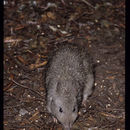Biology
provided by Arkive
Typically hiding by day in dense vegetation, the long-nosed potoroo emerges under the cover of night to forage. It covers the forest floor with short hops, digging small holes in the ground in search of the underground fungal fruiting bodies that it thrives on (5) (6). These fungi live on the roots of eucalyptuses, and indeed most vascular plants, and enhance the plants' ability to uptake nutrients through a relationship known as mycorrhizal symbiosis. Thus, in spreading the fungal spores in its faeces, the long-nosed potoroo, like other potoroos, is considered a critical link in the forest's ecological web (7). Although considered to be mycophagous by preference, the long-nosed potoroo will also feed on roots, tubers, insects, larvae, and other soft-bodied animals (6) (8). In addition, during the winter months, and especially on overcast days, it may forage during the hours of daylight (5) (6) (8). Individuals occupy small home ranges of two to five hectares and tend to be solitary, except during the breeding season (5) (6).
Breeding takes place year round, but peaks in early spring and late summer, with females capable of two reproductive bouts each year. A single young is born 38 days after mating, the longest gestation period known for any marsupial (1) (5) (6). After birth, the developing potoroo crawls into its mother's pouch, where it attaches itself to a teat and remains for the next four months. The young become independent after another five to six weeks, sexually mature at 12 months, and normally live for four to five years in the wild (1) (5).
Conservation
provided by Arkive
The long-nosed potoroo occurs in several protected areas across its range (1). Furthermore, owing to its status as a threatened species in Australia, a national recovery plan is in preparation, and in New South Wales a number of priority actions have been drawn up (1) (6). These include wide ranging measures such as the control of feral animals, the implementation of appropriate fire regimes, and the protection of suitable long-nosed potoroo habitat (6).
Description
provided by Arkive
In the words of Charles Darwin, who dragged a fleeing specimen from its refuge, the long-nosed potoroo “is an animal, as big as a rabbit, but with the figure of a kangaroo” (3). Indeed, this compact marsupial belongs to a family sometimes referred to as the rat-kangaroos (4). The soft, loose fur is grey to brown above and light grey below, while the partially prehensile tail is sometimes tipped with white (4) (5) (6). The ears are short and rounded, and as its name suggests, this species has a long, tapering nose, with a naked tip (5). The hind-limbs are well developed and heavily muscled like those of a kangaroo, while the short but muscular fore-limbs bear small paws, with forward-pointing spatulate claws used for digging (2) (5).
Habitat
provided by Arkive
This species inhabits coastal heath, and dry and wet sclerophyll forests, and generally requires areas of dense ground cover that provide shelter from predators (1) (6).
Range
provided by Arkive
The long-nosed potoroo is found on the south-eastern coast of Australia from Queensland to eastern Victoria, with populations also on Tasmania and some of the Bass Strait islands (1) (6).
Status
provided by Arkive
Classified as Least Concern (LC) on the IUCN Red List (1).
Threats
provided by Arkive
Although there are no major threats to the long-nosed potoroo, the combined impact of habitat loss, predation by introduced cats, dogs and foxes, and inappropriate fire and logging regimes are considered to be cause for concern. As a consequence this species is classified as a threatened species by national and local government in Australia (1) (6).

